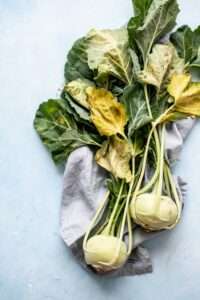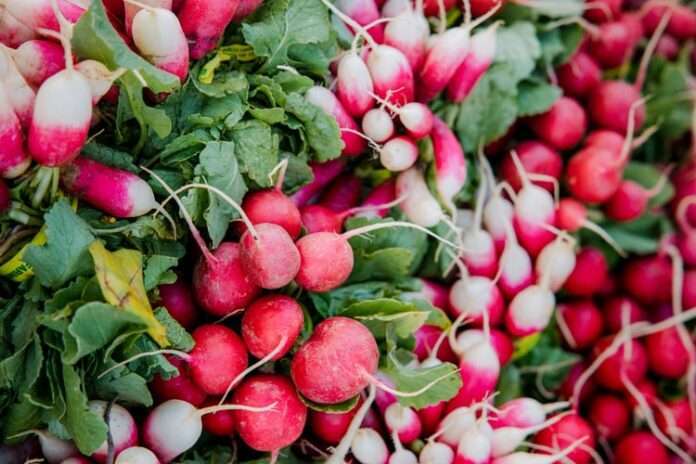
There’s nothing quite like pulling a crisp root vegetable from newly thawed ground and prepping it for the table in just a few minutes. Radishes, carrots, turnips and beets are cold-hardy staples that fill the gaps when little else grows. Because they are so versatile, they too easily become the only root crops we bother to grow. Yet there are less-common roots for every season, and growing them in succession with other crops can help loosen and renew soil.
This year, why not make space for something a little out of the ordinary—perhaps a long-forgotten cultural staple or an unconventional relative of a well-known root vegetable? Here’s a handful of ideas:
CELERIAC
Celeriac (Apium graveolens var. rapaceum) is the perfect antidote to winter doldrums. Its edible, knobby base emerges from the ground in cool weather, conveniently expanding the soil for other crops to follow. Celeriac’s leafy green stalks resemble celery, but this plant is hardier and easier to grow. (Celeriac and celery originated from the same wild species in the Mediterrenean; both are members of the parsley family.)
While celeriac leaves and stalks are perfectly edible, its warty base hides the real treat. Once the lumps and bumps are peeled away, the mild, aromatic flesh pairs beautifully with other roasted root veggies. When boiled down, the creamy flesh makes a delicious soup base. Perhaps its most famous preparation is celeri remoulade, a classic French dish that combines grated celeriac root with tangy mayonnaise.
Celeriac adapts to most climate zones. In cooler areas, start seeds indoors about two months before the final spring frost date. Transplant seedlings eight inches apart just before that final frost. Celeriac is a slow-grower, maturing in 90 to 120 days. The swollen stem (hypocotyl) is ready for harvest when it reaches three to six inches across.
Generally, celeriac prefers moist, fertile soil and full sun to part shade. Varieties with different size stems, days to harvest and degrees of cold hardiness are available in seed catalogs. In USDA Zone 7 and warmer, successive late-summer and fall planting produces winter and spring harvests. In these milder areas, plants will overwinter if they’re covered in leaf mulch. Celeriac grows well alongside nitrogen-fixing peas, greens and radishes.
KOHLRABI
Kohlrabi (Brassica oleracea var. gongylodes), like celeriac, produces an odd-looking edible swollen stem that sits just above the soil line. Stiff leaf stalks protrude in a rosette from the base. The harvested plant looks a bit like an alien turnip, with a purple, green or white hypocotyl. Once the outer stalks are removed and the smooth, tough outer skin is peeled away, kohlrabi is delicious eaten raw, pickled or roasted. It has a sweet yet pungent flair, similar to other roots in the Brassica family. The base is rich in vitamins C and B6 and it is an excellent source of fiber. Though you’ll want to discard the stalks, don’t toss the leaves on the compost pile. They make a great alternative to kale.
Kohlrabi seeds should be sown directly in the ground, where they germinate quickly. This is a cool-season crop, but it can be stretched for harvest in spring, fall and winter. Seeds germinate when temperatures are between 45 and 85 degrees (F), though cool temperatures are optimal for growth. In northern zones, sow seeds between April and mid-May for summer harvest. In temperate climates, seeds sown in midsummer through early fall yield a winter crop.
Kohlrabi prefers full sun and fertile, well-draining soil. When seedlings are big enough to handle, thin them to four inches apart in rows one foot apart. Harvest kohlrabi when the globes reach two to three inches round.
Brassicas release biotoxic compounds into the soil, fighting fungi, bacteria and pests. They are therefore an excellent choice for growing between other crops. Crop rotation is important for kohlrabi, though: don’t plant it where other Brassica family members, such as kale, cabbage, broccoli and cauliflower, recently grew. Aromatic cool-season crops like dill, celery and culinary sage grow well alongside kohlrabi.
SCORZONERA
Most roots grown in cool weather loosen soil and create openings for crops that follow, but longer tap roots offer supreme natural tillage. Taprooted vegetables such as carrots, parsnips and daikon radish loosen compacted soil in a process known as biodrilling. Hair-like roots branch off and decompose in the soil, creating pathways for water infiltration. Forage radish is best for biodrilling, but it’s maybe not the tastiest.
For something a little out of the ordinary and definitely more flavorful, scorzonera (Scorzonera hispanica) fits the bill. Its long, dark taproot covered in hairy roots earns it a long list of interesting monikers, from black salsify to black oyster plant and serpent root. Don’t be deterred by its name, which derives from the Italian scorza negra, or black peel. That tough outer layer peels away to reveal crisp, faintly oyster-flavored white flesh. Though it may look and taste a little exotic, scorzonera is closely related to salsify, which grows abundantly on the West Coast. Scorzonera is also common in European cuisine, where it’s eaten raw or steamed like asparagus.
Salsify and scorzonera fall in the Asteraceae family and share similar growth habits. Sow seeds in late spring or summer in a sunny location with loose soil. Thriving in Zones 6 through 9, scorzonera is perennial, with fragile roots the first year. A second year of growth makes harvesting a bit easier; a light frost even sweetens the flavor.
BLACK RADISH
A discussion of roots would be incomplete without the well-loved radish. ‘Cherry Belle’ radishes are often the first vegetables children learn to grow, and they’re a mainstay in most kitchen gardens. When fast-growing red globe and French breakfast varieties took hold in the United States, slower-growing winter radishes lost their seats at the table. Spanish black radish (Raphanus sativus var. niger) remains a European staple. Like scorzonera, its crisp white
flesh is protected by a tough, dark skin. There are both round and oblong varieties, and both are quite spicy. Macerating them in salt water tones down the zest. Like other radishes, Spanish black sweetens when braised in butter or roasted.
Winter radishes ripen to the size of a turnip, and go in the ground around the same time. In temperate climates, successive planting in midsummer yields ripe radishes in fall and winter. Cold-hardy varieties are planted after the last spring frost, for early summer harvest. Most varieties mature in about 55 days and store well for several weeks in the refrigerator.
In addition to expanding culinary breadth, growing a variety of crops enhances soil’s regenerative potential. Large-scale agriculture sometimes dictates the food we become accustomed to, and hence the crops we grow in back-yard gardens. Crops that were once regional staples are forgotten when we find new homes and form new habits. This year, why not get back to our roots with a tasty new crop or two?

